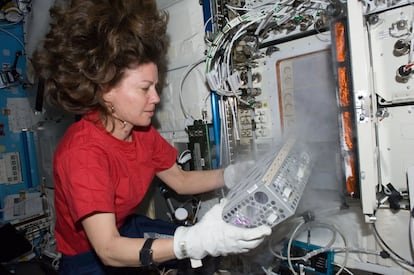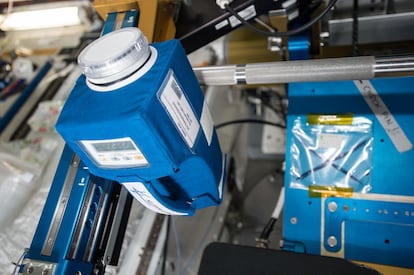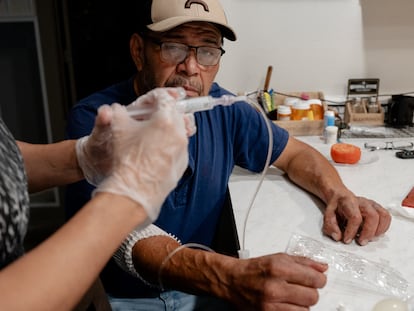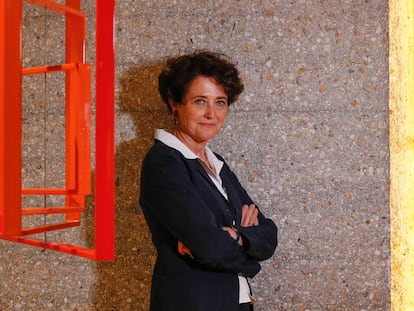Mutant superbugs pose a threat to human life in space
Research aboard the International Space Station reveals that some microorganisms become more aggressive and dangerous beyond Earth

If we ever find ourselves living off Earth, we’ll bring other species with us — for example, animals and plants to feed on. But we’ll also be accompanied by a host of uninvited stowaways: bacteria, fungi, and other microorganisms. What will happen to these microbes in extraterrestrial environments remains a mystery. For years, research has been using the International Space Station (ISS) as a testing ground to study the effects of space on these tiny creatures. And what they’re discovering is, to say the least, disturbing: some microbes are becoming more dangerous.
The history of microbes in space dates back a long time: scientists began sending microorganisms into the atmosphere in stratospheric balloons in 1935. Unmanned satellites and orbital and lunar missions followed. The ISS has served as a microbial laboratory for its quarter-century of existence. In 2006, a team of researchers led by Arizona State University sent cultures of the bacterium Salmonella typhimurium — known for causing food poisoning in cases of spoiled mayonnaise or undercooked tortilla — aboard the space shuttle Atlantis. The scientists discovered that “space flight samples exhibited enhanced virulence,” as they explained the following year in the journal PNAS.
By analyzing what made these space bacteria more infectious than their cousins on Earth, the researchers found the culprit: a protein called Hfq whose alteration affected 73 other proteins. The scientists confirmed in terrestrial simulations that the microgravity of space reduces the friction of the liquid medium with the bacteria, creating conditions similar to those when the bacteria infect a host organism.
Salmonella became more infectious because it thought it was in the gut. As project leader Cheryl Nickerson said at the time, bacteria “are clever: they respond to an environmental signal they see during the natural course of an infection.” Nickerson and her colleagues found that this effect could be neutralized by varying the composition of the medium.
The microbiome of the ISS
The problem is infinitely more complex. On the one hand, microgravity is only one of the factors in the space environment that affect microbes. Another is the elevated radiation levels compared to Earth. In addition, experiments such as Nickerson’s are carried out under controlled conditions on cultured bacteria. However, since humans carry millions of microbes with them, they have also made the ISS their home.
Since 2015, NASA’s Microbial Tracking project began cataloging the station’s microbiome, discovering around 20 disease-causing bacteria. The research was subsequently expanded to include microbes present within the crew and to study mutations that could potentially increase the virulence of these microorganisms.

In addition to NASA, other space agencies involved in the ISS have undertaken their own projects. BioRisk and TEST, by the Russian space agency Roscosmos, have analyzed microbes and their genetic changes on the station’s surfaces, also finding bacteria on the surface that could have been transported from the atmosphere, or on spacecraft. The Japanese agency JAXA has examined bacterial and fungal populations.
Research has found that skin microbes are predominant on the space station, particularly Staphylococcus bacteria and Malassezia fungi. Additionally, it has been found that astronauts’ microbiomes change during their stay on the ISS, with other, less common microorganisms starting to proliferate. Undoubtedly, the most striking finding from various studies is that microbes adapt to life in space, becoming more aggressive: they tend to form biofilms: masses of cells bound by a protective mucus-like substance, and they also develop resistance to antibiotics.
In 2018, several antibiotic-resistant strains of Enterobacter bugandensis were detected on the ISS, a bacterium first described in 2011 in a maternity ward in Tanzania, where it caused severe neonatal infections. Scientists have monitored the evolution of these microbes to prevent them from threatening the health of astronauts. In 2024, researchers from NASA’s Microbial Tracking program and the Indian Institute of Technology in Madras (IIT) analyzed 13 of these strains, discovering that the station’s stress conditions favor the proliferation of mutants. “Microbes continue to puzzle us by growing in the most challenging conditions,” said project co-director Karthik Raman, from IIT Madras.
Extreme survivors
The study identified key genes and possible molecular mechanisms that lead these bacteria to become more virulent in space, with the help of other microbes. “Our research uncovers the microbial community interactions of how certain benign microorganisms help to adapt and survive opportunistic human pathogen, E. bugandensis, in the unfavourable conditions of the International Space Station,” said Kasthuri Venkateswaran, co-director of the study at NASA.
Venkateswaran and his team examined five newly discovered bacterial species found on the ISS and compared their genomes to their closest Earth-based relatives. They found a consistent pattern: space microbes exhibit adaptations to microgravity and enhanced DNA repair mechanisms to counteract radiation exposure. While the pathogenic potential of these species remains uncertain, the mutations observed could potentially heighten their virulence by enabling them to form biofilms and evade the immune system.
According to Venkateswaran, these findings could help design countermeasures against opportunistic pathogens. However, the implications extend far beyond astronaut health. If humans ever embark on interplanetary travel, as envisioned by aerospace pioneer Konstantin Tsiolkovsky, a major question looms: how will we address the challenge of microbial contamination? Solutions like Boeing’s antimicrobial coating, now being tested on the ISS, are aimed at preventing space missions from inadvertently encouraging superbugs that could — for space colonists — potentially be a real extraterrestrial threat.
Sign up for our weekly newsletter to get more English-language news coverage from EL PAÍS USA Edition
Tu suscripción se está usando en otro dispositivo
¿Quieres añadir otro usuario a tu suscripción?
Si continúas leyendo en este dispositivo, no se podrá leer en el otro.
FlechaTu suscripción se está usando en otro dispositivo y solo puedes acceder a EL PAÍS desde un dispositivo a la vez.
Si quieres compartir tu cuenta, cambia tu suscripción a la modalidad Premium, así podrás añadir otro usuario. Cada uno accederá con su propia cuenta de email, lo que os permitirá personalizar vuestra experiencia en EL PAÍS.
¿Tienes una suscripción de empresa? Accede aquí para contratar más cuentas.
En el caso de no saber quién está usando tu cuenta, te recomendamos cambiar tu contraseña aquí.
Si decides continuar compartiendo tu cuenta, este mensaje se mostrará en tu dispositivo y en el de la otra persona que está usando tu cuenta de forma indefinida, afectando a tu experiencia de lectura. Puedes consultar aquí los términos y condiciones de la suscripción digital.
More information
Archived In
Últimas noticias
Brazil seduces tourists once more: Over nine million visitors and a new record
Gaza’s environmental apocalypse: ‘What we have left is not soil, it’s contaminated waste’
The end of TPS threatens thousands of Haitians in Miami: ‘Returning is a death sentence’
Release of political prisoners in Venezuela: a gesture of openness under Trump’s shadow
Most viewed
- Charles Dubouloz, mountaineering star, retires at 36 with a farewell tour inspired by Walter Bonatti
- CBS in crisis after pulling a report on Trump’s deportations to El Salvador (which later leaked online)
- December Social Security and SSI payments: Dates, double checks and the 2026 COLA increase
- The Florida Keys tourist paradise is besieged by immigration agents: ‘We’ve never seen anything like this’
- Bukele clan fumes over investigation exposing their new wealth










































